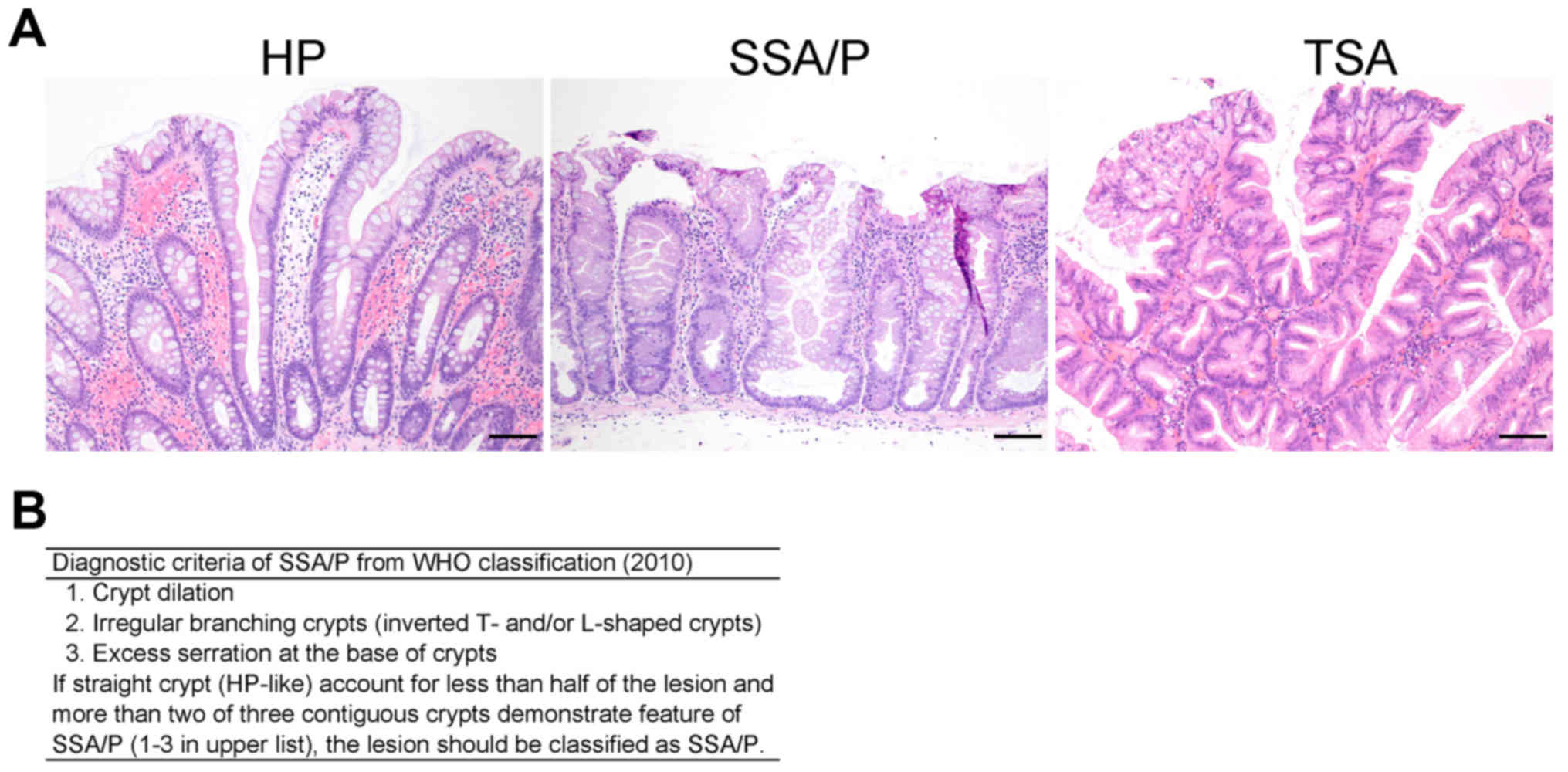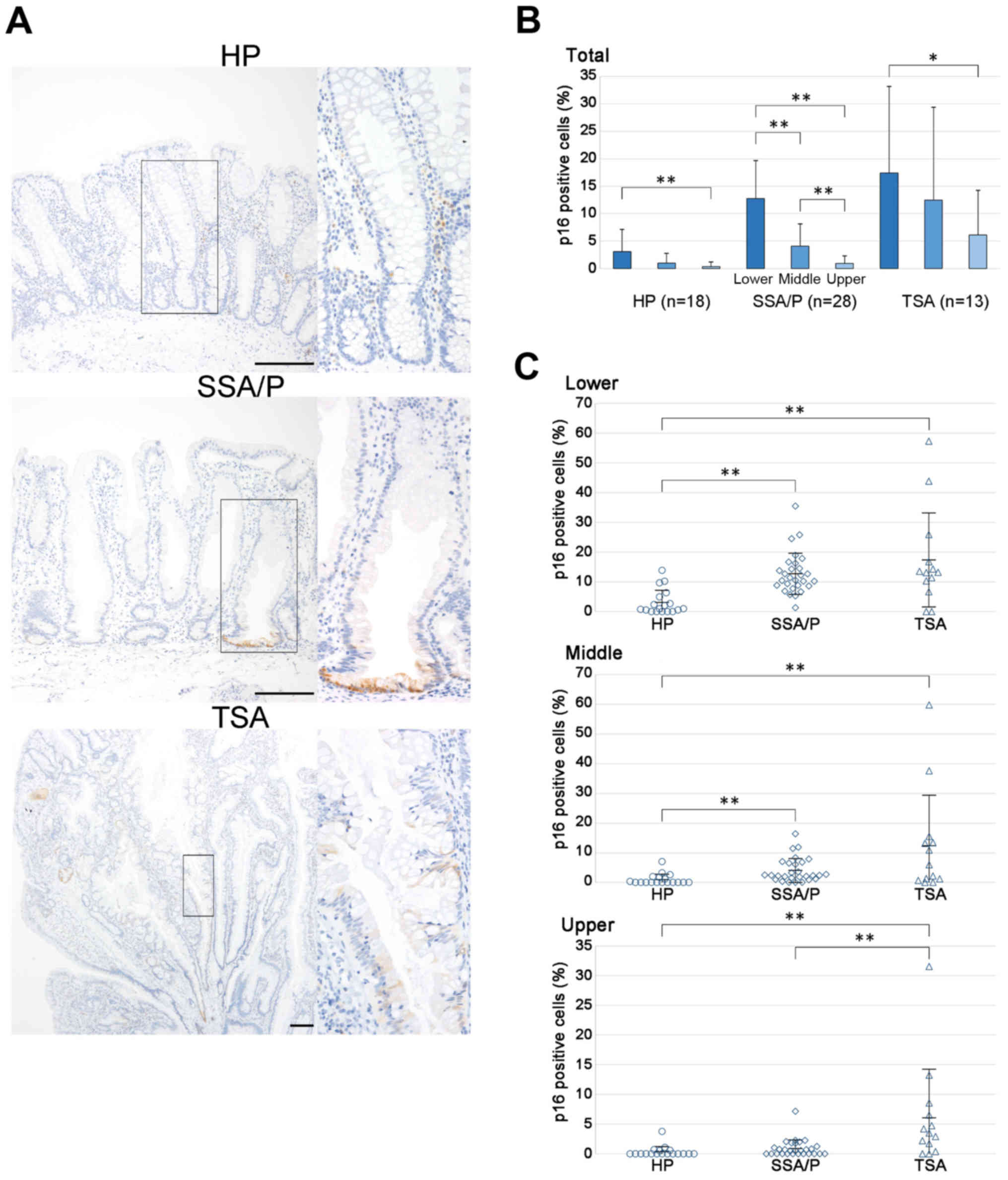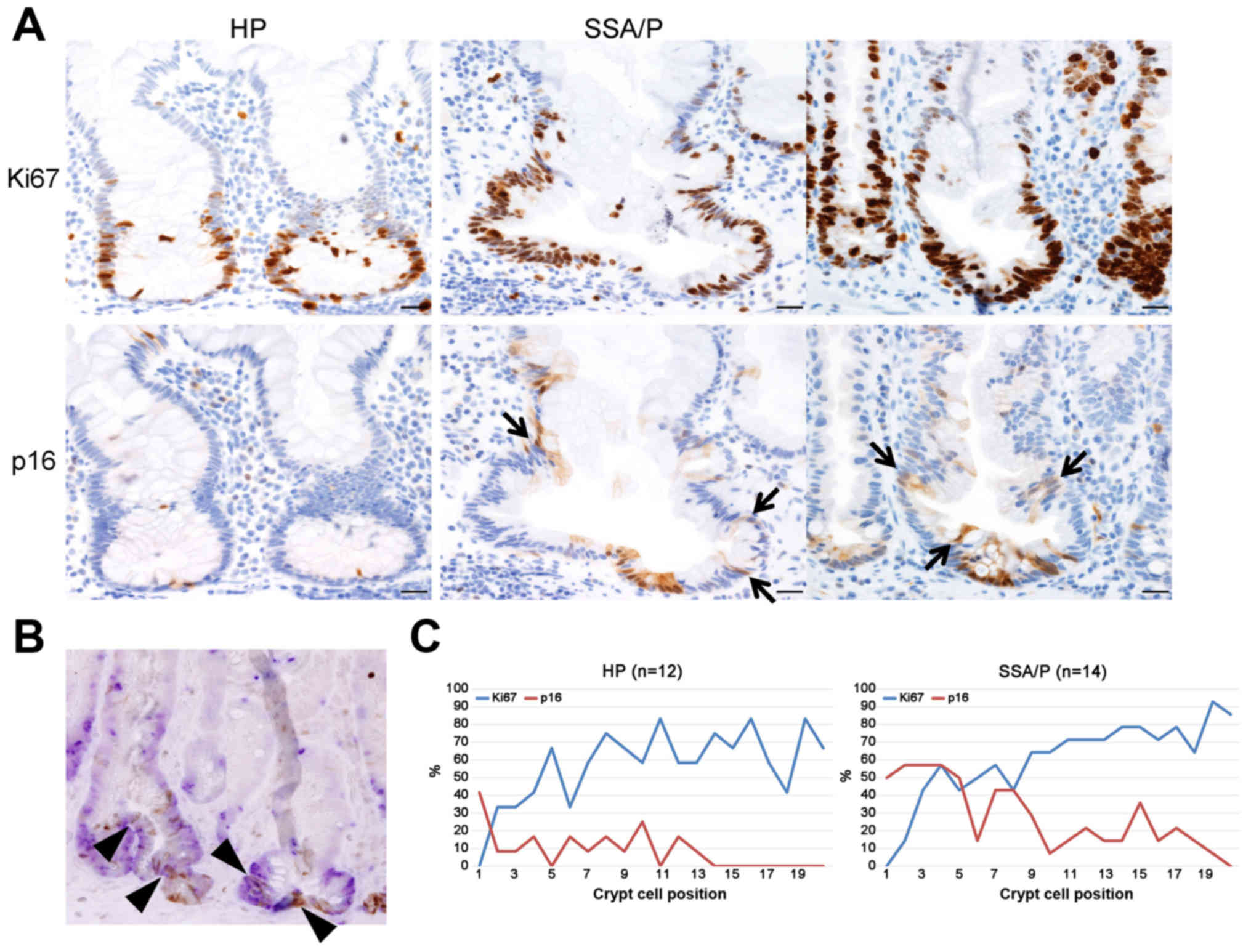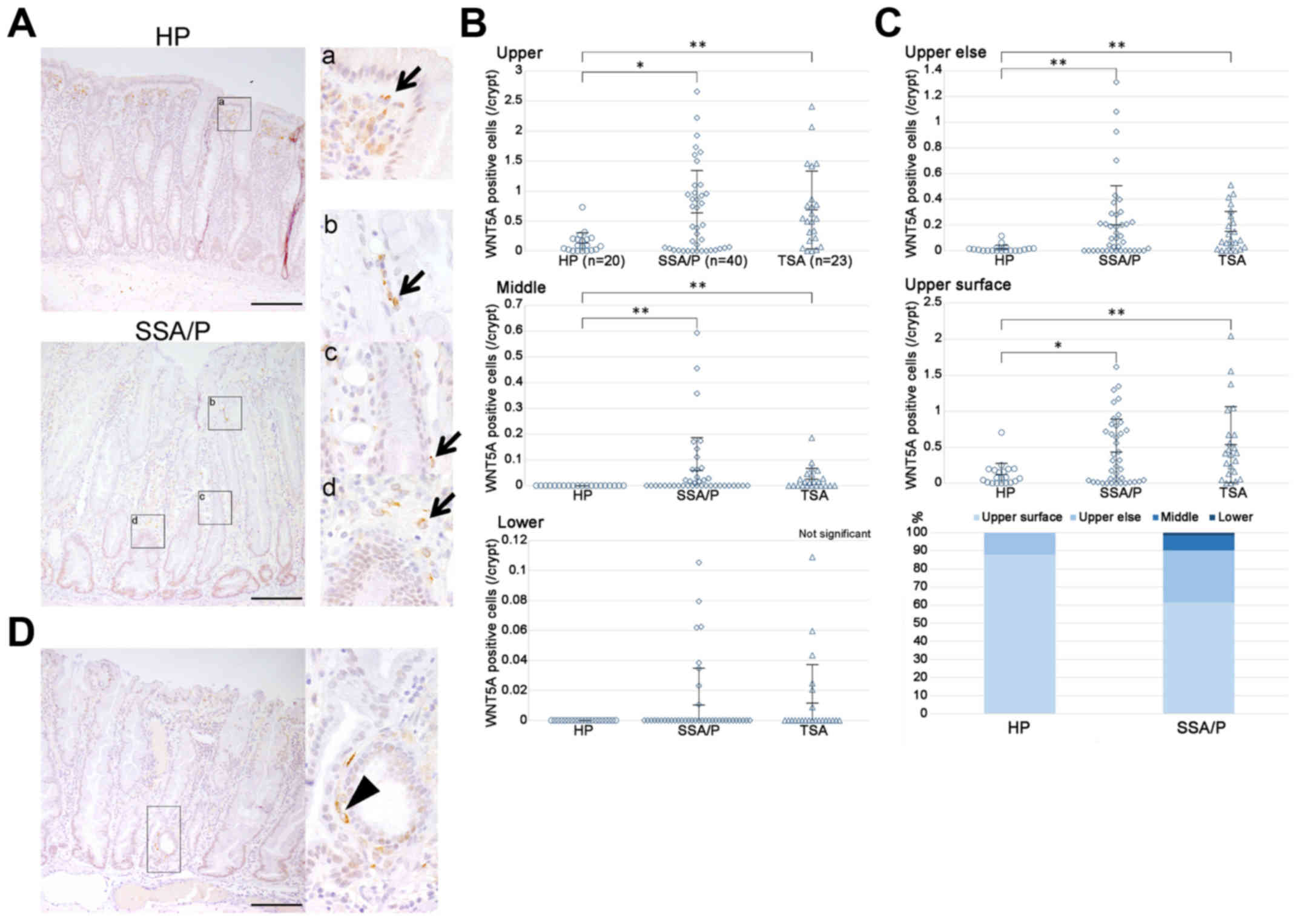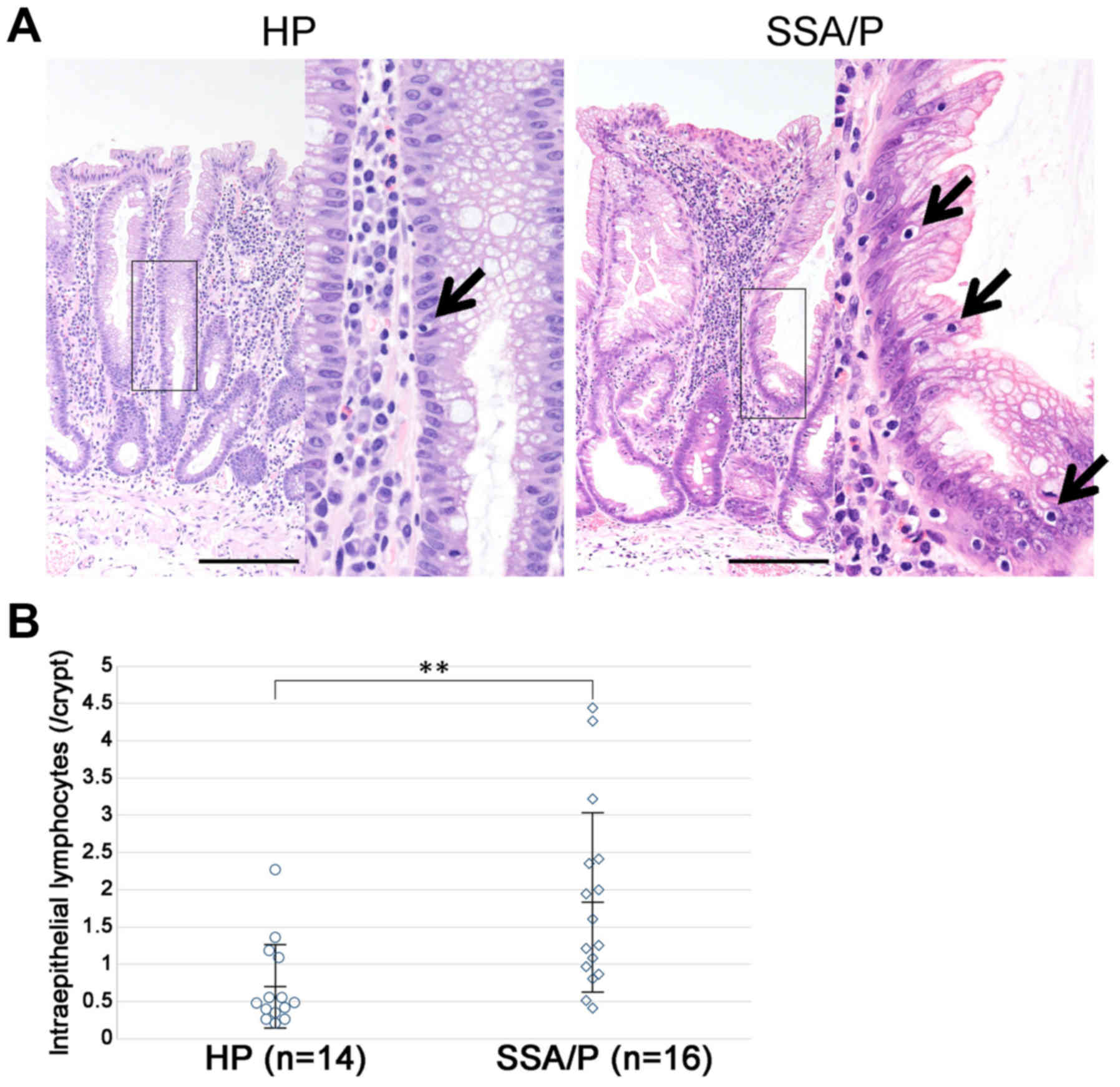Introduction
Serrated lesions in the colorectum are characterized
morphologically by elongated crypts and a saw-toothed pattern of
the crypt epithelium. The lesions are classified into hyperplastic
polyps (HPs), sessile serrated adenomas/polyps (SSA/Ps), and
traditional serrated adenomas (TSAs) by the World Health
Organization (WHO) (1,2). These serrated lesions are similar not
only in morphological appearance, but also in terms of molecular
features, such as genetic and epigenetic changes (3–7). These
molecular changes are found even in HPs (4,6,8), and
the sequence of transformation from HPs to SSA/Ps has been thought
to be premalignant. On the other hand, SSA/P diagnostic criteria,
debated by many researchers, are fundamentally based on morphology
in hematoxylin and eosin (HE) sections (9,10).
Thus, the categorization of serrated precursor lesions,
particularly HPs and SSA/Ps, still often varies among pathologists.
The HP-SSA/P sequence is predominantly observed in the right-sided
colon, which is different from the classical adenoma-carcinoma
sequence (11). In contrast, TSAs
are frequently found in the left side of colon (12), suggesting that their pathogenesis
may differ from that of SSA/Ps.
p16INK4a (p16), a cyclin-dependent kinase
inhibitor, is a component of the INK4 family, which induces
cellular senescence and growth arrest (13–15).
The upregulation of p16 expression in premalignant lesions
and its inactivation during malignant transformation is believed to
be a common event in carcinogenesis in many organs (16,17).
The loss of p16 expression caused by CDKN2A promoter
hypermethylation contributes to malignant transformation in the
serrated dysplasia-carcinoma sequence (18). However, it is not yet known whether
the upregulation of p16 is linked to the serrated precursor
lesions in the microscopic morphology.
In the differentiation between HP and SSA/P, some
studies have suggested that a change in the Ki67-positive
proliferative zone and asymmetrical change cause an architectural
disturbance (9,19). Another study has demonstrated that
upregulation of p16 due to oncogene-induced senescence in
the premalignant serrated lesions occurs prior to a loss of
p16 in malignant transformation (18), indicating that cellular
proliferation and/or senescence may involve morphological changes;
however, the association with the localization of these molecular
markers has not yet been specified.
In terms of crypt branching and fission, a recent
study has revealed that Wnt5a is a key molecule in the process of
crypt regeneration, particularly in crypt fission of a mouse model
(20). In the mouse intestine,
Wnt5a is secreted by stromal pericrypt myofibroblasts and is
necessary for proliferation and branching of crypt epithelium and
maintaining of homeostasis (21,22).
Additionally, dysplasia branching from SSA/Ps has been reported to
be closely associated with a high rate of intraepithelial
lymphocytes (IELs) (23). However,
the localization and role of WNT5A and IELs in the HP-SSA/P
sequence are unknown.
The aim of this study was to clarify the
morphological differences between SSA/P and other serrated lesions
by analyzing immunohistochemistry (IHC) of Ki67 cellular
proliferation marker and p16 senescence marker and furthermore, to
investigate the involvement of WNT5A and IELs in the mechanism
underlying development of serrated lesions, particularly
SSA/Ps.
Materials and methods
Ethics statement
Human samples were obtained from Gifu University
Hospital, and written informed consent was obtained from all
individuals. This study was approved by the Institutional Review
Board of Gifu University. All experiments were carried out in
accordance with the approved guidelines of Gifu University.
Samples
Eighty-eight serrated colorectal polyps were
resected endoscopically or surgically from 65 patients (aged 36 to
87 years) at the Gifu University Hospital, between the years 2012
and 2016 (Table I). The number of
the polyps examined is HPs, n=22 (endoscopically, n=21; surgically,
n=1), SSA/Ps, n=42 (endoscopically, n=33; surgically, n=9), and
TSAs, n=24 (endoscopically, n=19; surgically, n=5).
 | Table I.Clinical characteristics of serrated
lesions. |
Table I.
Clinical characteristics of serrated
lesions.
|
Characteristics | HP (n=22) | SSA/P (n=42) | TSA (n=24) | P-value |
|---|
| Age, years |
|
|
| 0.037 (HP vs.
TSA)a |
| Mean ±
SD | 63.8±12.1 | 68.8±10.5 | 70.9±8.22 |
|
| Sex, n (%) |
|
|
| NS |
|
Male | 13 (59.09%) | 30 (71.43%) | 16 (66.67%) |
|
|
Female | 9 (40.91%) | 12 (28.57%) | 8
(33.33%) |
|
| Location, n
(%) |
|
|
| 0.02 (SSA/P vs.
TSA)b |
| Right
colon | 11 (50.00%) | 26 (61.90%) | 7 (29.17%) |
|
| Left
colon | 11 (50.00%) | 16 (38.10%) | 17 (70.83%) |
|
| Diameter, mm |
|
|
| 0.004 (HP vs.
SSA/P)a |
| Mean ±
SD | 7.36±5.65 | 11.1±6.58 | 12.7±11.0 | 0.026 (HP vs.
TSA)a |
| Endoscopic
morphology, n (%) |
|
|
| NS |
| Is | 11 (50.00%) | 14 (33.33%) | 11 (45.83%) |
|
|
Isp | 3 (13.64%) | 4 (9.52%) | 2 (8.33%) |
|
| Ip | 0 (0.00%) | 1 (2.38%) | 3 (12.50%) |
|
|
IIa | 8 (36.36%) | 20 (47.62%) | 3 (12.50%) |
|
|
Is+IIa | 0 (0.00%) | 2 (4.76%) | 1 (4.17%) |
|
| UN | 0 (0.00%) | 1 (2.38%) | 4 (16.67%) |
|
Histological evaluation and
immunohistochemistry (IHC)
The histological diagnosis of the serrated lesions
was evaluated based on their morphology in hematoxylin and eosin
(H&E) staining (Fig. 1A).
SSA/Ps were distinguished from conventional HPs on the basis of the
following microscopic features: 1) crypt dilation, 2) irregularly
branching crypts, and 3) horizontally arranged basal area of the
crypts (inverted T- and/or L-shaped crypts) (9) (Fig.
1B). Lesions demonstrating ≥2 of these findings were classified
as SSA/Ps. Lesions that had none of these findings were classified
as HPs. TSAs were diagnosed by a complex villous architecture,
lined by columnar cells with densely eosinophilic cytoplasm and
pencillate nuclei (2).
All samples analyzed were
formalin-fixed and paraffin-embedded tissue sections
Immunohistochemistry (IHC) was performed using a
Histofine® Simple Stain MAX PO kit (Nichirei, Tokyo,
Japan) according to the manufacturer's protocol. We used anti-Ki67
(mouse monoclonal antibody, clone MIB-1, 1:100 dilution; Dako
Corp., Carpinteria, CA, USA, rabbit polyclonal antibody, clone SP6,
1:100 dilution; Abcam, Cambridge, MA, USA), anti-p16 (mouse
monoclonal antibody, clone E6H4, 1:1 dilution; Ventana, Tucson, AZ,
USA), and anti-Wnt5a/b (rabbit monoclonal antibody, clone C27E8,
1:50 dilution; Cell Signaling, Danvers, MA, USA). For
double-staining IHC, both Ki67 and p16 antibodies were used as
primary antibodies. Signal amplification was performed with
alkaline phosphatase-biotin complex, followed by a chromogenic
reaction with alkaline phosphatase substrate kit (Vecta Blue;
Vector Laboratories, Burlingame, CA, USA) and DAB as previously
described (24).
To evaluate the Ki67- and p16-positive index, two
representative adjacent crypts detected from the bottom to the
surface of the crypt were selected in each specimen. The percentage
of Ki67- or p16-expressing cells per crypt was calculated in upper,
middle, and lower parts of crypt, separately (Fig. 2B). To evaluate the Wnt5a-positive
index, approximately 50 to 200 crypts were selected in each
specimen and the number of positive cells per crypt was calculated
in the upper, middle, and lower parts of the crypt, separately. The
upper portion was subdivided into the ‘upper surface’ (cells
adjoining the surface epithelium) and ‘upper else’ sections
(Fig. 2B). Counting of IELs in the
crypt epithelium was performed in H&E sections. The number of
IELs in a crypt of HPs and SSA/Ps was counted in a single hot-spot
high-power field. We excluded the specimens which were not suitable
for the evaluation in each examination. Histological evaluation was
performed by two experienced pathologists (H.T. and K. H.) who were
blinded to the clinical data.
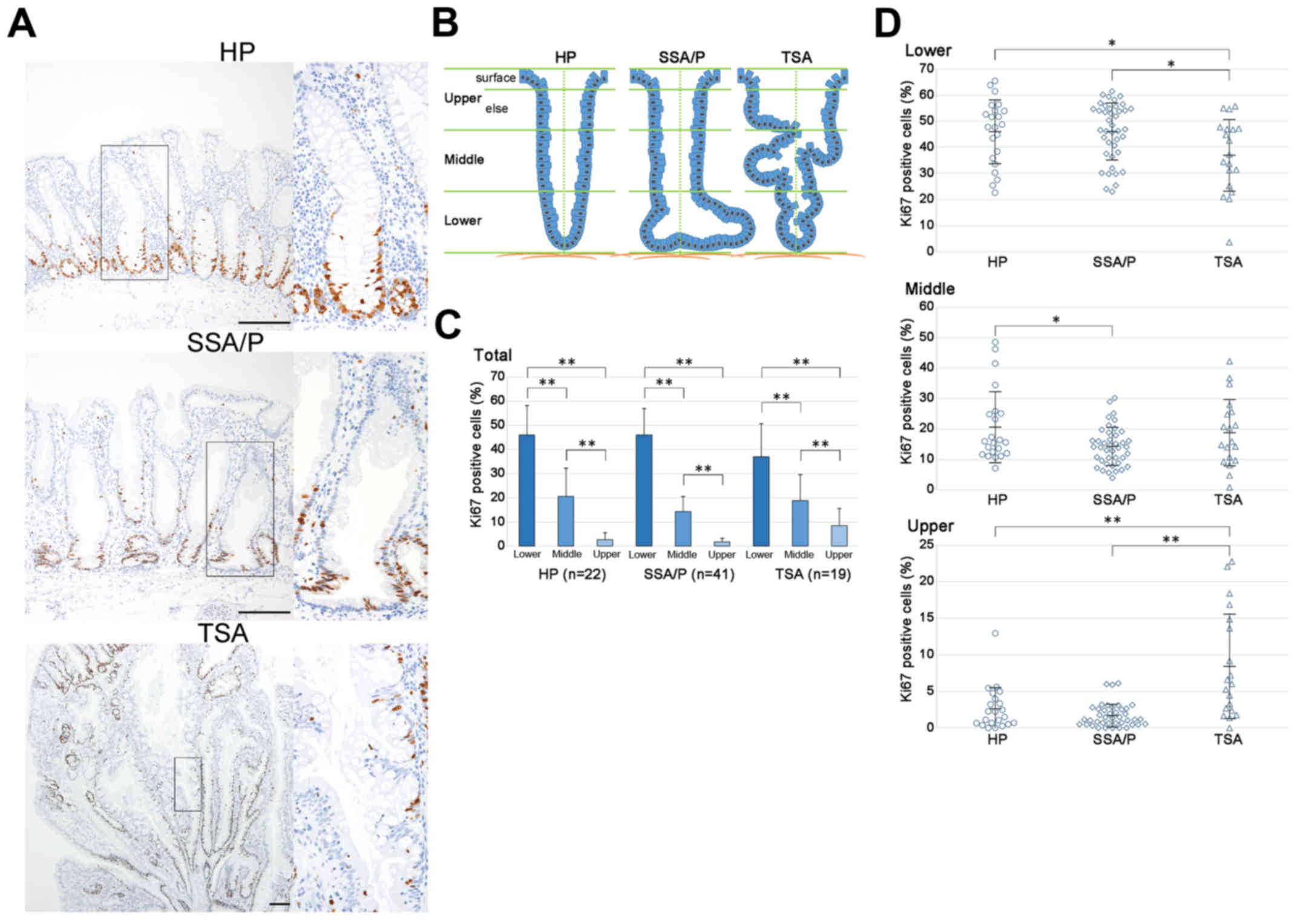 | Figure 2.Ki67 expression in HP, SSA/P, and
TSA. (A) Representative images of immunohistochemical expression of
Ki67 in serrated lesions (scale bars: 200 µm). (B) Evaluation by
dividing a crypt into lower, middle, and upper zones. The upper
zone is subdivided into ‘upper surface’ and ‘upper else’. (C and D)
Ki67-labeling index in HP, SSA/P, and TSA, in the whole (C) and
individual parts (D). The central line is the arithmetic mean;
error bars are ± SD. (*P<0.05; **P<0.01, TSA, lower vs.
middle in C and lower, HP vs. TSA in D are t-test. Others are
Wilcoxon's rank-sum test). HP, hyperplastic polyp; SSA/P, sessile
serrated adenoma/polyp; TSA, traditional serrated polyp. |
Statistical analysis
The data were analyzed using the t-test, Fisher's
exact test, and Wilcoxon's rank-sum test. P<0.05 or P<0.01
were considered statistically significant.
Results
Clinical characteristics
The clinical characteristics of the patients are
summarized in Table I. No
significant differences in sex and endoscopic morphology were found
between the HP, SSA/P, and TSA groups. However, the mean age of
patients with TSAs (70.9±8.22 years) was significantly older than
that of patients with HPs (63.8±12.1 years). SSA/Ps were
predominantly observed in the proximal colon (61.90%), while TSAs
were found in the distal colon (70.83%); the difference in location
between SSA/P and TSA was statistically significant. The mean size
of HPs (7.36±5.65 mm) was significantly smaller than that of SSA/Ps
and TSAs (11.1±6.58 and 12.7±11.0 mm, respectively).
Ki67 proliferative cells expand from
the lower to the middle zone in the HP-SSA/P sequence, but not in
TSAs
To investigate whether morphological changes in
serrated lesions are associated with cellular proliferation, we
performed IHC for Ki67 in human HPs (n=22), SSA/Ps (n=41), and TSAs
(n=19). In HPs and SSA/Ps, Ki67-positive cells were predominantly
found in the lower third of the crypt (Fig. 2A). In TSAs, Ki67-positive cells were
also observed in the lower third of the crypt; however, these cells
broadly expanded toward the upper part of the crypt in TSAs in
comparison with HPs and SSA/Ps.
To clarify the difference in proliferative activity
between HPs, SSA/Ps, and TSAs, we calculated the Ki67-positive rate
by dividing a crypt into three zones, i.e., lower, middle, and
upper zones (Fig. 2B). In normal
colon epithelium, the proliferative zone, marked by Ki67-positive
cells, is localized in the lower third of the crypt (data not
shown). In HPs, SSA/Ps, and TSAs, the Ki67-positive rates were high
in the lower zone of the crypt (Fig.
2C). In HPs, Ki67-positive rates in the lower, middle, and
upper zones of the crypt decreased significantly (46.06, 20.62, and
2.63%, respectively). In SSA/Ps, Ki67-positive rates in the lower,
middle, and upper zones of the crypt also decreased significantly
(46.1, 14.31, and 1.70%, respectively). Similarly, in TSAs, the
Ki67-positive rates in the lower, middle, and upper zones of the
crypt decreased significantly (36.99, 18.78, and 8.44%,
respectively).
Next, we evaluated the differences in the
proliferation rates between the zones in serrated lesions. In the
upper zone, the proliferation rate of TSAs was significantly higher
than that in HPs and SSA/Ps (Fig.
2D). In the middle zone, the proliferation rate of HPs was
significantly higher than that of SSA/Ps. In the lower zone, the
proliferation rates of HPs and SSA/Ps were significantly higher
than that of TSAs. In the whole crypt, i.e. the lower, middle, and
upper zones, there was no significant difference in the
proliferation rates of HPs, SSA/Ps, and TSAs (23.37, 22.92, and
22.57%, respectively). These data demonstrated that the
proliferative cells of SSA/Ps expanded from the lower to the middle
zone, although the rate of proliferative cells was not
significantly different between HPs and SSA/Ps. Furthermore, the
proliferative cells of TSAs expanded broadly to all three zones and
were less frequently found in the lower zone in TSAs than in those
of HPs and SSA/Ps. These results suggest that there might be a
marked difference in the HP-SSA/P sequence and TSA development in
terms of the proliferation and senescence of cells in the
crypt.
Significant increase of p16 expression
in the crypt bottom of SSA/Ps
To clarify whether cellular senescence is associated
with serrated lesions, we performed IHC for p16, the key enforcer
of cell cycle arrest, in our cohort (HPs, n=18; SSA/Ps, n=28; TSAs,
n=13). Few p16-positive cells were observed in the normal colon
epithelium (data not shown) and HPs (Fig. 3A). In several HP cases, p16-positive
cells were observed in the crypt bottom. In SSA/Ps, p16-positive
cells were predominantly found in the bottom of the crypt, in
particular in L- or T-shaped crypts, albeit sparsely. Furthermore,
p16-positive cells were found in the cleft of the crypt. Except for
the epithelium, a few stromal cells, such as lymphocytes and
granulocytes, around the crypt showed positive staining. In TSAs,
p16-positive epithelial cells broadly expanded across the crypt,
although there were few positive cells.
Next, we evaluated differences between the rates of
p16-positive senescent cells among the three zones in serrated
lesions, in a similar manner as for the calculation of
Ki67-positive cells. In HPs, SSA/Ps, and TSAs, the p16-positive
rate of the lower zone was significantly higher than that of the
upper and middle zones (Fig. 3B).
In HPs, p16-positive rates in the lower, middle, and upper zones of
the crypt decreased significantly (3.09, 1.02, and 0.37%,
respectively). Similarly, p16-positive rates decreased
significantly in SSA/P (12.76, 4.12, and 0.93%, respectively) and
in TSA (17.41, 12.45, and 6.11%, respectively) in the lower,
middle, and upper zones of the crypt. Consequently, the rate of the
p16-positive cells followed the same trend as the Ki67-positive
cells (Fig. 2C) in the crypts of
serrated lesions.
We evaluated the differences in the p16-positive
senescent cell rates between the crypt zones in serrated lesions.
In the upper zone, the rate of the senescent cells in TSAs was
significantly higher than those in HPs and SSA/Ps (Fig. 3C). In the middle zone, the rate of
senescent cells in SSA/Ps was significantly higher than that in
HPs, and the rate of senescent cells in TSAs was significantly
higher than that in HPs. In the lower zone, the rate of senescent
cells in SSA/Ps was significantly higher than that in HPs, and the
rate of senescent cells in TSAs was significantly higher than in
HPs. In the crypt as a whole, i.e. the lower, middle, and upper
zones, there were significantly more senescent cells in SSA/Ps than
in HPs, and significantly more senescent cells in TSAs than in
SSA/Ps (2.37, 5.81, and 11.22% in HPs, SSA/Ps, and TSAs,
respectively).
These data demonstrate that there were very few
p16-positive senescent cells in the central bottom of the elongated
crypt in HPs; they were sparsely observed in the cleft of L- or
T-shaped crypts in SSA/Ps, and were detected broadly across the
crypt in TSAs. This suggests that there may be a difference in
HP-SSA/P sequence and TSA progression in terms of senescence of the
crypt epithelium.
Absence of p16-positive senescent
cells co-expressed with Ki67-positive proliferating cells in L- and
T-shaped crypts of SSAPs
We hypothesized that the sparse distribution of
p16-positive senescent cells in the HP-SSA/P sequence may
contribute to the distinctive morphology, such as the L- and
T-shaped crypts of SSA/Ps. To verify this hypothesis, we performed
IHC in the serial section and performed double IHC for Ki67 and p16
in some crypts of SSA/P. In serial sections, Ki67- and p16-positive
cells did not colocalize in the bottom of crypts in HPs or SSA/Ps
(Fig. 4A). In HPs, a few
p16-positive cells were found in the central of the crypt bottom,
while Ki67-positive cells were distributed in the lower zone of the
crypt, except for the central of the crypt bottom. In SSA/Ps,
Ki67-positive cells were mainly found in the lower zone of the
crypt and dilated crypts, although p16-positive cells were observed
in the lower bottom of the cleft. These findings were confirmed
using double IHC for Ki67 and p16 (Fig.
4B).
Next, we evaluated the overlap of Ki67- and
p16-positive cells in the bottom and lower zones of the crypt in
HPs and SSA/Ps by counting cells (Fig.
4C). In HPs, the majority of Ki67-positive cells were distinct
from p16-positive cells in terms of their localizations. Most
p16-positive cells were located immediately below the proliferation
zone, marked by Ki67, and were expressed mainly in the bottom
(base) of the crypt, which was defined as the +1 position. In
SSA/Ps, the majority of Ki67-positive cells were also distinct from
p16-positive cells in terms of their localizations; however, most
p16-positive cells overlapped with Ki67-positive cells, and were
expressed predominantly at the +2 to +8 positions. These results
suggest that sporadic cellular senescence may rearrange the
distribution of proliferating cells, followed by elongation of the
crypt during proliferation, which could induce distinctive
architectural change around the bottom of the crypt in SSA/Ps.
Stromal Wnt5a-positive cells descend
along the pericrypt and are located at the crypt cleft in
SSA/Ps
We investigated whether Wnt5a is involved in the L-
and T-shaped morphological changes in SSA/Ps; we performed IHC for
Wnt5a in the same specimens investigated for Ki67 and p16 (HPs,
n=20; SSA/Ps, n=40; TSAs, n=23). In HPs, Wnt5a-positive cells were
observed in the stroma of the upper zone and immediately below the
superficial epithelium, and were identified as myofibroblasts and
lymphocytes (Fig. 5A). In SSA/Ps,
Wnt5a-positive cells expanded from the upper to the middle zone of
the crypt, laterally. To clarify the distribution of Wnt5a-positive
cells in serrated lesions, we measured the number of positive cells
per crypt, divided into the upper, middle, and lower zones, in HPs,
SSA/Ps, and TSAs. The number of stromal Wnt5a-positive cells in
SSA/Ps and TSAs was significantly higher than that in HPs in the
upper and middle zones, but not in the lower zone (Fig. 5B). When we divided the upper zone
into ‘upper else’ and ‘upper surface’ areas (Fig. 2B), the difference in the number of
stromal Wnt5a-positive cells was larger and more significant in
‘upper else’ area than ‘upper surface’ area between HPs and SSA/Ps
(Fig. 5C). The difference was found
not only in the number, but also in the distribution of these cells
in HPs and SSA/Ps. These results indicated that stromal
Wnt5a-positive cells may have migrated from the upper to middle
zones in the HP-SSA/P sequence. Of note, some stromal
Wnt5a-positive cells were found around clefts of the nascent front
of crypts in SSA/Ps (Fig. 5D). This
suggests that stromal Wnt5a-positive cells may be critical during
the L- and T-shaped morphology changes in SSA/Ps.
Significant increases in
intraepithelial lymphocytes in SSA/Ps
Thus, we evaluated IELs in the serrated precursor
lesions, i.e., HPs and SSA/Ps (Fig.
6A). The mean number of IELs per crypt was 0.71±0.56 and
1.83±1.20 in HPs and SSA/Ps, respectively (Fig. 6B). The number of IELs in SSA/Ps was
significantly increased as compared to HPs. This observation
suggested that an increase in IELs was associated with the HP-SSA/P
sequence as well as with the dysplasia-carcinoma sequence in the
serrated pathway.
Discussion
In this study, we demonstrated that the number and
distribution of epithelial proliferative (Ki67-positive) and
senescent (p16-positive) cells contribute to distinctive morphology
changes in the HP-SSA/P sequence of the serrated pathway.
Furthermore, we showed that stromal Wnt5a-positive cells increase
along the crypt elongation and branching, and the number of IELs
increase in the HP-SSA/P sequence.
Previous studies have shown that the number and
distribution of Ki67-positive cells differed between HPs and
SSA/Ps, with a higher Ki67-positive rate and asymmetrical
distribution in SSA/Ps (9).
However, such differences were not confirmed in our study. This
might be because 6/22 (27.3%) of HPs classified in our study were
>10 mm, which are described as large hyperplastic polyp (LHPs),
and have been considered to be synonymous with SSA/Ps in the WHO
2010 classification (Fig. 1B)
(25–27). A recent study (28) supports our findings that there was
no difference in Ki67 expression between HPs and SSA/Ps.
Our data suggested that p16-positive cells increased
and expanded during the progression from HP to SSA/P in the
HP-SSA/P sequence. In human serrated lesions, oncogene-induced
senescence is induced by initiating BRAF mutations, which lead to
premalignant lesions, with upregulation of p16 and growth
limitation by the senescence barrier (18). We demonstrated that there were few
p16-positive senescent cells in the bottom of crypts in HPs,
although there were no cells in normal crypts. Furthermore, in
SSA/Ps, p16-positive senescent cells were distributed mainly in a
patchy fashion and at the clefting point. Noteworthy, those
p16-positive cells did not co-localize with Ki67-positive
proliferating cells. Kreigl et al (18) showed that p16 and Ki67 expression
were mutually exclusive in premalignant lesions, such as serrated
polyps; however, the distribution of expression of both these
proteins was unclear in SSA/Ps. Our results indicated that a patchy
distribution of senescent and proliferating cells may distinguish
the morphology in the HP-SSA/P sequence (Fig. 7).
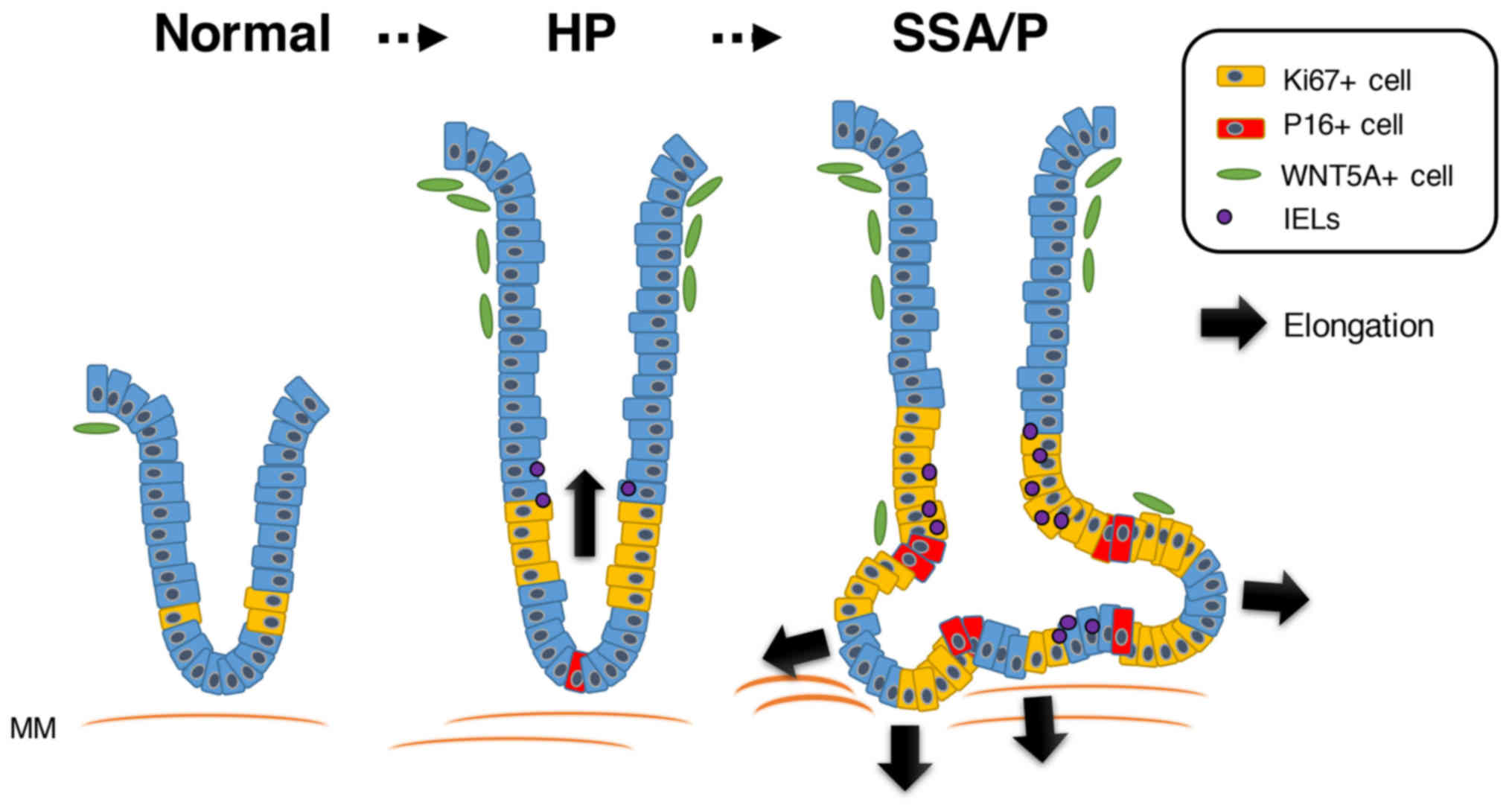 | Figure 7.Schematic diagram of the proposed
role of Ki67-, p16-, WNT5A-positive cells and IELs in the HP-SSA/P
sequence, particularly the elongation of the branching crypt, such
as L- and T-shaped crypts, in SSA/P. In HP, Ki67-positive
proliferative cells increase and some p16-positive senescent cells,
which arrest growth, appear in the bottom of the crypt (base), thus
leading to crypt elongation. Furthermore, stromal WNT5A-positive
cells increase in the upper zone, and several IELs are seen. In
SSA/P, p16-positive senescent cells increase and have a patchy
distribution in the crypt epithelium in the lower zone, and the
branching crypt elongates, which act as fixed supports.
WNT5A-positive cells descend along the pericrypt to the middle zone
and some cells are located in the cleft of the elongating crypts.
IELs increase in SSA/P. IELs, intraepithelial lymphocytes; MM,
muscularis mucosa; HP, hyperplastic polyp; SSA/P, sessile serrated
adenoma/polyp; TSA, traditional serrated polyp. |
Microscopically, in contrast to HPs and SSA/Ps, TSAs
are protuberant, exophytic, and villous, and have many ectopic
crypt foci, which is the hallmark of TSA lesions (29). We analyzed the Ki67-proliferative
and p16-senescent cells in TSAs, as well as in HPs and SSA/Ps. The
distribution of both Ki67- and p16-positive cells was broadly
expanded throughout the crypt and could clearly distinguish TSAs
from HPs and SSA/Ps. Furthermore, our data and those of previous
studies demonstrated that TSAs usually develop in the left-sided
colon, while SSA/Ps develop in the right-sided colon. This suggests
that TSAs may not be related to HPs and SSA/Ps in terms of
histological, molecular, and territorial pathogenesis.
It has been reported that stromal Wnt5a enhances
transforming growth factor-β signaling to reduce epithelial
proliferation and cause clefting of epithelial channels, and
clefting modifies the polarization of highly proliferative crypt
structures at wound margins, allowing them to branch into new crypt
units in the regeneration of crypts in mice (20). Of note, this phenomenon supports our
finding that stromal Wnt5a-positive cells were localized near the
cleft of crypts in human SSA/Ps. This indicates a morphological
similarity between regenerative branching and branching of crypts
in SSA/Ps. Furthermore, our results demonstrated that the number of
IELs in SSA/Ps was significantly increased as compared with that in
HPs, suggesting that inflammation may accelerate the morphological
changes in SSA/Ps. Hence, we hypothesized that the distinctive
morphological changes in SSA/Ps might be caused by reactive
changes, rather than by neoplastic changes, and SSA/Ps with
dysplasia may demonstrate distinct neoplastic changes. Furthermore,
histological and molecular studies are necessary to clarify the
pathogenesis of SSA/Ps that are distinguished by the presence of
dysplasia.
Recently, noncanonical Wnt signaling pathway, such
as WNT5A and WNT3A, has been implicated in the regulation of
mesenchymal stem cell differentiation, including adipogenic
differentiation (30). By WNT5A
activation, human adipose-derived stem cells can differentiate
neurogenic cells in a 3D microfluidic culture systems (31), thus suggesting that WNT5A activation
might be a key gene in neural differentiation of mesenchymal stem
cells (32). In gastrointestinal
polyps, primary neurogenic polyps are frequently observed (33). However, the pathogenesis remains
unclear. WNT5A may be associated with the development of the
neurogenic gastrointestinal polyps on not only surrounding tumor
microenvironment but also the stem cell differentiation.
Taken together, this study demonstrates evidence
that HP elongates and branches, based on the increase and patchy
distribution of senescent and proliferative cells, along with
activation of stromal and inflammatory cells, which contributes to
producing the L- and/or T-shaped crypts that are distinctive in
SSA/Ps. Our findings may facilitate understanding and improve
therapy of serrated lesions.
Acknowledgements
We thank Kyoko Takahashi, Ayako Suga, Masayoshi
Shimizu, and Reiko Kitazumi for assistance with the experiments.
This work was supported by grants from the Ministry of Education,
Culture, Sports, Science, and Technology of Japan: grant nos.
15K11289 and 26430111 (A.H. and H.T., respectively).
References
|
1
|
Snover D, Ahnen DJ, Burt RW and Odze RD:
Serrated polyps of the colon and rectum and serrated polyposis. WHO
Classification of Tumours of the Digestive System. 3. 4th. Bosman
FT, Carneiro F, Hruban RH and Theise ND: Lyon, France: IARC; pp.
160–165. 2010
|
|
2
|
Snover DC: Update on the serrated pathway
to colorectal carcinoma. Hum Pathol. 42:1–10. 2011. View Article : Google Scholar : PubMed/NCBI
|
|
3
|
Chan TL, Zhao W, Leung SY and Yuen ST:
Cancer Genome Project: BRAF and KRAS mutations in colorectal
hyperplastic polyps and serrated adenomas. Cancer Res.
63:4878–4881. 2003.PubMed/NCBI
|
|
4
|
Iino H, Jass JR, Simms LA, Young J,
Leggett B, Ajioka Y and Watanabe H: DNA microsatellite instability
in hyperplastic polyps, serrated adenomas, and mixed polyps: A mild
mutator pathway for colorectal cancer? J Clin Pathol. 52:5–9. 1999.
View Article : Google Scholar : PubMed/NCBI
|
|
5
|
Park SJ, Rashid A, Lee JH, Kim SG,
Hamilton SR and Wu TT: Frequent CpG island methylation in serrated
adenomas of the colorectum. Am J Pathol. 162:815–822. 2003.
View Article : Google Scholar : PubMed/NCBI
|
|
6
|
Spring KJ, Zhao ZZ, Karamatic R, Walsh MD,
Whitehall VL, Pike T, Simms LA, Young J, James M, Montgomery GW, et
al: High prevalence of sessile serrated adenomas with BRAF
mutations: A prospective study of patients undergoing colonoscopy.
Gastroenterology. 131:1400–1407. 2006. View Article : Google Scholar : PubMed/NCBI
|
|
7
|
Yang S, Farraye FA, Mack C, Posnik O and
O'Brien MJ: BRAF and KRAS mutations in hyperplastic polyps and
serrated adenomas of the colorectum: Relationship to histology and
CpG island methylation status. Am J Surg Pathol. 28:1452–1459.
2004. View Article : Google Scholar : PubMed/NCBI
|
|
8
|
Carr NJ, Mahajan H, Tan KL, Hawkins NJ and
Ward RL: Serrated and non-serrated polyps of the colorectum: Their
prevalence in an unselected case series and correlation of BRAF
mutation analysis with the diagnosis of sessile serrated adenoma. J
Clin Pathol. 62:516–518. 2009. View Article : Google Scholar : PubMed/NCBI
|
|
9
|
Fujimori Y, Fujimori T, Imura J, Sugai T,
Yao T, Wada R, Ajioka Y and Ohkura Y: An assessment of the
diagnostic criteria for sessile serrated adenoma/polyps: SSA/Ps
using image processing software analysis for Ki67
immunohistochemistry. Diagn Pathol. 7:592012. View Article : Google Scholar : PubMed/NCBI
|
|
10
|
Higuchi T, Sugihara K and Jass JR:
Demographic and pathological characteristics of serrated polyps of
colorectum. Histopathology. 47:32–40. 2005. View Article : Google Scholar : PubMed/NCBI
|
|
11
|
O'Brien MJ, Yang S, Mack C, Xu H, Huang
CS, Mulcahy E, Amorosino M and Farraye FA: Comparison of
microsatellite instability, CpG island methylation phenotype, BRAF
and KRAS status in serrated polyps and traditional adenomas
indicates separate pathways to distinct colorectal carcinoma end
points. Am J Surg Pathol. 30:1491–1501. 2006. View Article : Google Scholar : PubMed/NCBI
|
|
12
|
Chetty R, Hafezi-Bakhtiari S, Serra S,
Colling R and Wang LM: Traditional serrated adenomas (TSAs) admixed
with other serrated (so-called precursor) polyps and conventional
adenomas: A frequent occurrence. J Clin Pathol. 68:270–273. 2015.
View Article : Google Scholar : PubMed/NCBI
|
|
13
|
Schmitt CA: Cellular senescence and cancer
treatment. Biochim Biophys Acta. 1775:5–20. 2007.PubMed/NCBI
|
|
14
|
Collado M, Blasco MA and Serrano M:
Cellular senescence in cancer and aging. Cell. 130:223–233. 2007.
View Article : Google Scholar : PubMed/NCBI
|
|
15
|
Campisi J and di d'Adda Fagagna F:
Cellular senescence: When bad things happen to good cells. Nat Rev
Mol Cell Biol. 8:729–740. 2007. View
Article : Google Scholar : PubMed/NCBI
|
|
16
|
Gutierrez-Reyes G, del Carmen Garcia, de
Leon M, Varela-Fascinetto G, Valencia P, Tamayo Pérez R, Rosado CG,
Labonne BF, Rochilin NM, Garcia RM, Valadez JA, et al: Cellular
senescence in livers from children with end stage liver disease.
PLoS One. 5:e102312010. View Article : Google Scholar : PubMed/NCBI
|
|
17
|
Dankort D, Filenova E, Collado M, Serrano
M, Jones K and McMahon M: A new mouse model to explore the
initiation, progression, and therapy of BRAFV600E-induced lung
tumors. Genes Dev. 21:379–384. 2007. View Article : Google Scholar : PubMed/NCBI
|
|
18
|
Kriegl L, Neumann J, Vieth M, Greten FR,
Reu S, Jung A and Kirchner T: Up and downregulation of p16(Ink4a)
expression in BRAF-mutated polyps/adenomas indicates a senescence
barrier in the serrated route to colon cancer. Mod Pathol.
24:1015–1022. 2011. View Article : Google Scholar : PubMed/NCBI
|
|
19
|
Shida Y, Ichikawa K, Fujimori T, Fujimori
Y, Tomita S, Fujii T, Sano Y, Oda Y, Goto H, Ohta A, et al:
Differentiation between sessile serrated adenoma/polyp and
non-sessile serrated adenoma/polyp in large hyper plastic polyp: A
Japanese collaborative study. Mol Clin Oncol. 1:53–58.
2013.PubMed/NCBI
|
|
20
|
Miyoshi H, Ajima R, Luo CT, Yamaguchi TP
and Stappenbeck TS: Wnt5a potentiates TGF-β signaling to promote
colonic crypt regeneration after tissue injury. Science.
338:108–113. 2012. View Article : Google Scholar : PubMed/NCBI
|
|
21
|
Powell DW, Adegboyega PA, Di Mari JF and
Mifflin RC: Epithelial cells and their neighbors I. Role of
intestinal myofibroblasts in development, repair, and cancer. Am J
Physiol Gastrointest Liver Physiol. 289:G2–G7. 2005. View Article : Google Scholar : PubMed/NCBI
|
|
22
|
Gregorieff A, Pinto D, Begthel H, Destrée
O, Kielman M and Clevers H: Expression pattern of Wnt signaling
components in the adult intestine. Gastroenterology. 129:626–638.
2005. View Article : Google Scholar : PubMed/NCBI
|
|
23
|
Rau TT, Atreya R, Aust D, Baretton G, Eck
M, Erlenbach-Wünsch K, Hartmann A, Lugli A, Stöhr R, Vieth M, et
al: Inflammatory response in serrated precursor lesions of the
colon classified according to WHO entities, clinical parameters and
phenotype-genotype correlation. J Pathol Clin Res. 2:113–124. 2016.
View Article : Google Scholar : PubMed/NCBI
|
|
24
|
Tanaka K, Tomita H, Hisamatsu K, Nakashima
T, Hatano Y, Sasaki Y, Osada S, Tanaka T, Miyazaki T, Yoshida K, et
al: ALDH1A1-overexpressing cells are differentiated cells but not
cancer stem or progenitor cells in human hepatocellular carcinoma.
Oncotarget. 6:24722–24732. 2015. View Article : Google Scholar : PubMed/NCBI
|
|
25
|
Jass JR: Serrated adenoma of the
colorectum and the DNA-methylator phenotype. Nat Clin Pract Oncol.
2:398–405. 2005. View Article : Google Scholar : PubMed/NCBI
|
|
26
|
Warner AS, Glick ME and Fogt F: Multiple
large hyperplastic polyps of the colon coincident with
adenocarcinoma. Am J Gastroenterol. 89:123–125. 1994.PubMed/NCBI
|
|
27
|
Tinmouth J, Henry P, Hsieh E, Baxter NN,
Hilsden RJ, McGregor Elizabeth S, Paszat LF, Ruco A, Saskin R,
Schell AJ, et al: Sessile serrated polyps at screening colonoscopy:
Have they been under diagnosed? Am J Gastroenterol. 109:1698–1704.
2014. View Article : Google Scholar : PubMed/NCBI
|
|
28
|
Dayi N, Baba HA, Schmid KW and Schmitz KJ:
Increased expression of α-methylacyl-coenzyme A racemase (AMACR;
p504s) and p16 in distal hyperplastic polyps. Diagn Pathol.
8:1782013. View Article : Google Scholar : PubMed/NCBI
|
|
29
|
Chetty R: Traditional serrated adenoma
(TSA): Morphological questions, queries and quandaries. J Clin
Pathol. 69:6–11. 2016. View Article : Google Scholar : PubMed/NCBI
|
|
30
|
Yuan Z, Li Q, Luo S, Liu Z, Luo D, Zhang
B, Zhang D, Rao P and Xiao J: PPARγ and Wnt signaling in adipogenic
and osteogenic differentiation of mesenchymal stem cells. Curr Stem
Cell Res Ther. 11:216–225. 2016. View Article : Google Scholar : PubMed/NCBI
|
|
31
|
Choi J, Kim S, Jung J, Lim Y, Kang K, Park
S and Kang S: Wnt5a-mediating neurogenesis of human adipose
tissue-derived stem cells in a 3D microfluidic cell culture system.
Biomaterials. 32:7013–7022. 2011. View Article : Google Scholar : PubMed/NCBI
|
|
32
|
Cardozo AJ, Gómez DE and Argibay PF:
Neurogenic differentiation of human adipose-derived stem cells:
Relevance of different signaling molecules, transcription factors,
and key marker genes. Gene. 511:427–436. 2012. View Article : Google Scholar : PubMed/NCBI
|
|
33
|
Hechtman JF and Harpaz N: Neurogenic
polyps of the gastrointestinal tract: A clinicopathologic review
with emphasis on differential diagnosis and syndromic associations.
Arch Pathol Lab Med. 139:133–139. 2015. View Article : Google Scholar : PubMed/NCBI
|















